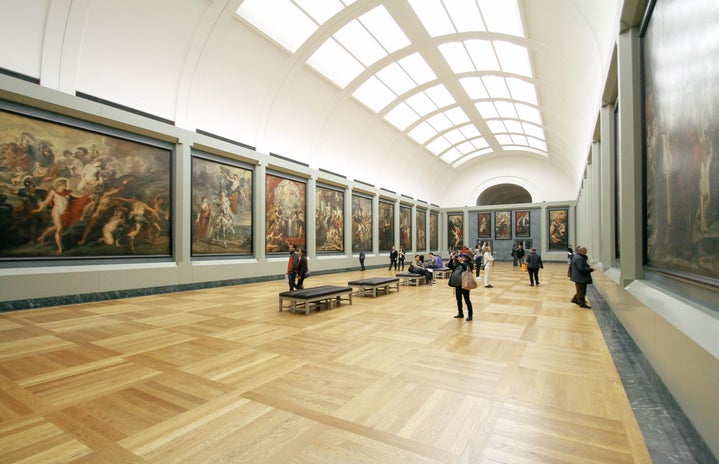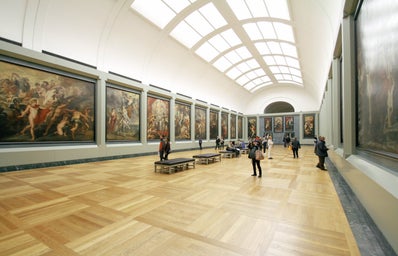Now nearly a year and a half ago, Katy Hessel’s debut book The Story of Art Without Men was released in bookstores around the UK. It was one of the first mainstream works centred exclusively around female artists and went on to win the Waterstones Book of the Year 2022 Award. The book was groundbreaking in its retelling of art history, reinserting women in their rightful places as pioneers of the creative arts. The title highlighted women’s exclusion from art history discourse, noting in particular the lack of references to women in Ernst Gombrich’s seminal work The Story of Art, often considered the most famous and accessible introductions to the subject.
Eighteen months on, has this effort to reinstate women into art history discourse continued more widely, or was this simply an isolated case?
The National Gallery, found at the heart of London’s Trafalgar Square, is one of many significant cultural hubs within the country’s capital. Housing a collection of over 2,300 works, key moments of art history are carefully preserved and on display between its walls, including that of artistic masters ranging from Caravaggio to Canaletto to Van Gogh. Clearly, it is not a museum lacking in famous names! But where do our long-forgotten and overlooked female artists fit into this archive?
As stated by the gallery’s website, only 21 of the 2,300 works were created by female artists, equating to roughly 0.9% of the overall collection. There is no arguing that it makes for a poor showing. However, this reality is not all negative as, of those 21 paintings, many are recognised as central pieces of the gallery’s collection and showcased accordingly. The gallery’s free daily tours, exploring between 3-4 of its particularly noteworthy pieces, has been known to include Gentileschi’s masterful ‘Self-portrait as Saint Catherine of Alexandria’. Whilst the work of female artists is far and few between within the museum, the paintings displayed do seem to possess equal standing to that of their male counterparts, arguably demonstrating a tentative move towards the meaningful reinsertion of women within art history.
The National Gallery’s gift shop also offers an insight into the standing of female artists within these institutions. During my last visit in September 2023, I observed book collections containing fascinating volumes both centred around the work of female artists as well as written and created by female art historians – texts such as The Short Story of Women Artists by Susie Hodge. However, one seemingly small, but nevertheless disconcerting, find has stuck with me. Having made my way to the postcard section, I took note of the thematic organisation of the packs of postcards featuring works from the gallery. One such theme was ‘Masterpieces’ which featured works from Holbein and Velazquez to name but a few, and not a single woman. — The postcards featuring the work of female artists? — These were ONLY included within the pack entitled ‘Women Artists’. Female creatives deserve equal, integrated spaces for the recognition of their masterpieces, not to be held in a separate category at arm’s length from the (male) ‘Greats’.
A third point of discussion is temporary, featured exhibitions. Here, we can take a step back from the National Gallery to invite a broader consideration of a variety of art museums.
Zooming out paints a much more positive image as we are increasingly seeing women being featured, within the temporary collections and exhibitions of mainstream museums, in a range of positions from artists to subjects themselves. Notable examples would be the Royal Hibernian Academy’s 2023 ‘It took a century: women artists and the RHA’ collection and the upcoming Tate Britain 2024 exhibition ‘Now You See Us’, both of which champion shining the light on female artists. The Tate Modern’s 2023-2024 ‘Women in Revolt’ collection features both women artists and women as the subject of the art, rejecting depictions of an often passive female subject. Finally, the Victoria and Albert Museum’s ‘DIVA’ exhibition, whilst not exclusively centred around women, presents important themes of strength within femininity and womanhood.
The question of whether women are finally receiving their due within art history, and whether we are witnessing a meaningful reinsertion of female work into artistic canons, is one with a mixed answer. Indeed, exhibitions featuring female art are increasing, and museum curators and guide tours are treating these works as significant parts of their collections. However, the number of works remains low, and there are instances in which art created by women is very much kept in a separate category still to this day. Whilst steps in the right direction are being taken, there is still important work to be done for women to truly gain their rightful place within the pantheon of the history of art.


